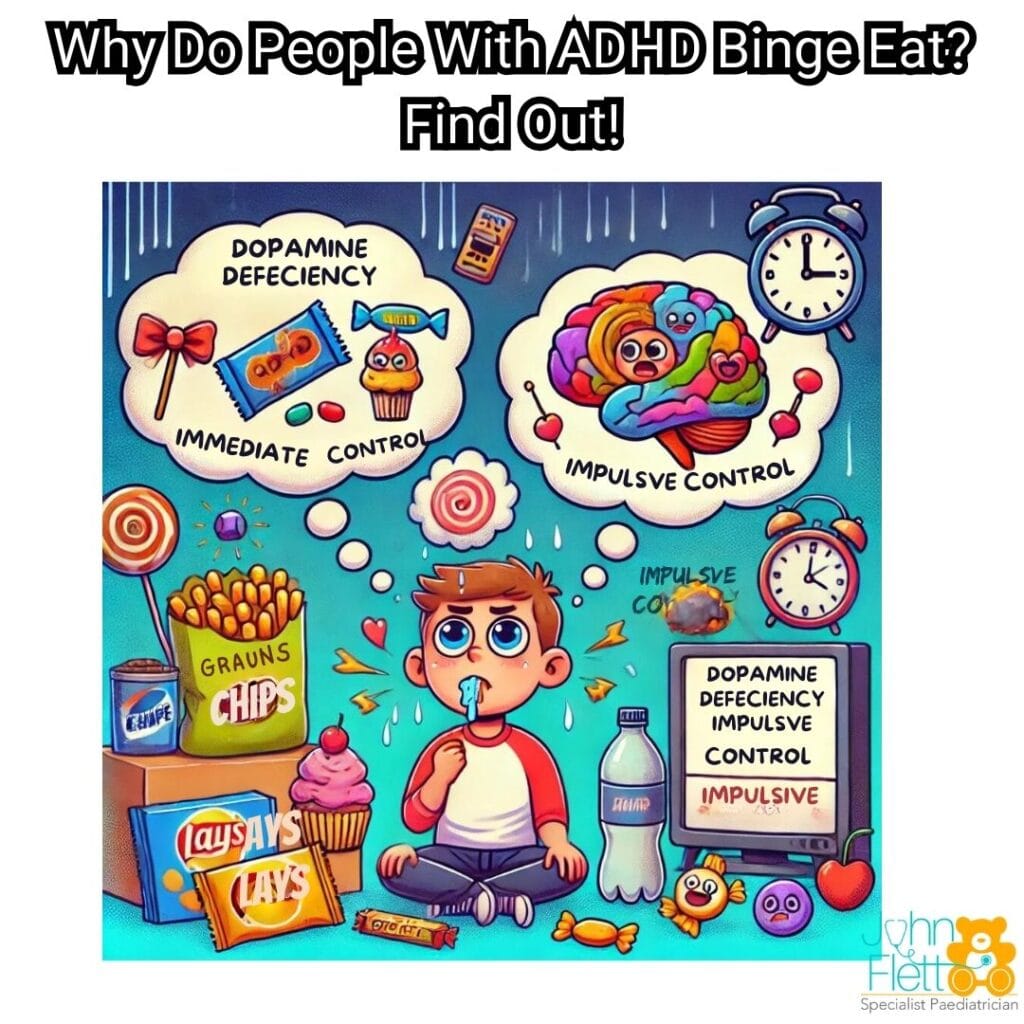🍽️ ADHD and Binge Eating: Why It Happens and How to Help Your Child

Meta Description: Learn why children and teens with ADHD may struggle with binge eating, and discover practical, compassionate strategies to support healthier habits and emotional well-being.
A Battle with Food That’s Not About Hunger
If your child with ADHD seems to constantly snack, crave sweets, or eat far past the point of fullness, you’re not alone. Many parents notice that their child’s relationship with food feels out of balance. Binge eating and ADHD often go hand in hand—not because of a lack of willpower, but because of how the ADHD brain is wired.
This isn’t just about food. It’s about dopamine, impulse control, and emotional regulation. And with the right understanding and support, this pattern can improve.
Let’s explore why binge eating happens in ADHD—and what you can do to help.
Why Does ADHD Often Lead to Binge Eating?
1. Impulsivity and the Need for Instant Rewards
Kids with ADHD often struggle to delay gratification. If there’s a biscuit or sweet in sight, they might eat it before thinking twice—because their brain craves now, not later.
They’re more likely to:
- Eat quickly without feeling full
- Struggle to pause before grabbing another snack
- Prefer sugary, high-reward foods
2. Time Blindness and “Living in the Moment”
Children with ADHD live very much in the “now.” They may not register the long-term effects of their actions, like overeating leading to tummy aches or future health concerns. Their focus is on how they feel right this second—and food offers a quick comfort.
3. A Dopamine Deficiency in the Brain
Dopamine is the brain’s “feel-good” chemical. In ADHD, levels of dopamine are lower, meaning it takes more stimulation for the brain to feel rewarded. That’s why your child might:
- Crave sugary snacks (a quick dopamine hit)
- Binge-watch shows or play video games for hours
- Seem to “need more” to feel satisfied
4. Using Food to Self-Soothe
Food—especially sugar—can act like a short-term emotional bandage. For children who feel rejected, anxious, or overwhelmed, eating might be a way to cope. But this creates a cycle: the more they eat to feel better, the more dependent they become on food to regulate their mood.
5. Sensitivity to Rejection and Criticism
Many children with ADHD are highly sensitive. A small bit of criticism can feel huge, triggering shame or sadness. In these moments, binge eating can become a way to escape or comfort themselves.
10 Parent-Friendly Strategies to Support Healthier Eating Habits
Here’s what you can do at home to gently reduce binge eating and help your child feel more in control:
✅ 1. Spot the Triggers
Help your child track their mood and hunger in a simple journal. Look for patterns: Do they snack more when stressed, bored, or criticised?
✅ 2. Keep Meals Regular
Skipping meals increases the chance of later overeating. Aim for:
- Three balanced meals
- Two healthy snacks per day
- Protein-rich breakfasts to start the day right
✅ 3. Encourage Mindful Eating
Teach your child to slow down:
- Chew slowly and savour bites
- Eat at the table (not in front of a screen)
- Pause halfway and ask, “Am I still hungry?”
✅ 4. Manage Stress Creatively
Help your child find other ways to soothe themselves:
- Breathing exercises
- Listening to music
- Drawing or journaling feelings
✅ 5. Make Movement Fun
Exercise boosts dopamine naturally. Activities like dancing, swimming, or trampolining can help them feel good without needing snacks.
✅ 6. Stick to a Sleep Routine
Lack of sleep makes cravings worse and lowers self-control. Try:
- Consistent bedtimes
- No screens an hour before bed
- Calming wind-down routines
✅ 7. Avoid Restrictive Diets
Strict rules often backfire. Instead of saying, “No sugar ever,” try “Let’s have a small treat after lunch” or “Let’s bake something together.”
✅ 8. Seek Professional Help When Needed
If binge eating is affecting your child’s health or mood, it’s worth speaking to a professional. Cognitive Behavioural Therapy (CBT) and nutritional counselling can be very helpful.
✅ 9. Offer Alternatives to Eating
When your child feels the urge to snack, suggest:
- Drawing or building something
- Walking the dog
- Calling a friend
- Reading a comic or listening to music
✅ 10. Stay Hydrated
Thirst can masquerade as hunger. Keep water bottles handy and encourage regular sips throughout the day.
Treatment: The Game Changer
When ADHD is treated—whether through medication, therapy, or lifestyle support—binge eating often improves too. Why? Because the brain starts functioning with better regulation. Impulses are easier to manage, emotions are more balanced, and the need for food as self-medication decreases.
ADHD treatment isn’t just about school performance. It’s about quality of life—including healthy relationships with food.
Final Thoughts: Compassion Over Control
If your child is struggling with binge eating, remember—it’s not about laziness or greed. It’s their brain’s way of seeking comfort and regulation in a world that often feels overwhelming. With understanding, routine, and the right support, you can help your child build a healthier, happier relationship with food and themselves.
📞 Need Support?
If you’d like professional advice on ADHD, emotional regulation, or eating challenges, don’t hesitate to contact Dr John Flett.
📍 Visit us at 8 Village Road, Kloof, Durban
📞 Call us on 031 1000 474
💻 Remote consultations available via Zoom for your convenience



Responses